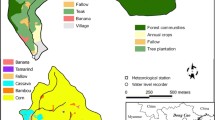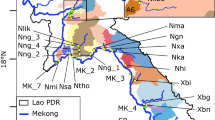Abstract
Faecal coliform (FC) levels in surface water and clams (Ruditapes decussatus) and variations in environmental parameters were studied in two bivalve harvesting areas in the Alvor lagoon (southern Portugal). Land use and cover characteristics in adjacent subwatersheds were also analysed to assess their contributions as sources of faecal contamination. High FC levels in clams from the harvesting area in the most urbanized subwatershed (impervious surface coverage ≈ 10.5%) were positively associated with rainfall and with the cooler periods of the year. FC levels in clams from the least urbanized subwatershed were generally very low and did not present any detectable seasonal trend. From these results, it was concluded that the periodic deterioration of the microbiological quality of clams derives from the cumulative impact of the reservoir of faecal contamination created in urbanized areas, entering into the lagoon during storm water runoff.
Similar content being viewed by others
References
Anderson, J. R., Hardy, E. E., Roach, J. T., & Witmer, R. E. (2001). A land use and land cover classification system for use with remote sensor data: A revision of the land use classification system as presented in US Geological Survey Circular 671. Geological Survey Professional Paper, 964. Available at http://edc-iaddwebaugie.usgs.gov.akadns.net/LCI/pdf/anderson.pdf.
Anon (1998) Decreto-Lei n° 293/98 de 18 de Setembro: Normas sanitárias relativas à produção e à colocação no mercado de moluscos bivalves vivos e exigências relativas aos equipamentos e estruturas dos centros de depuração e de expedição de moluscos bivalves vivos (in Portuguese). Diário da República, I A Série, 216, 4828–4838.
Anon (2004). Regulation of 29 April 2004 of the European Parliament and of the Council (EC 854/2004): Specific rules for the organization of official controls on products of animal origin intended for human consumption. Official Journal of the European Communities, L155, 206–321.
APHA (1985). Laboratory procedures for the examination of seawater and shellfish, fifth edition. Greenberg, A.E. and Hunt, D.A., Washington DC.
ASQAAC (2002). Australian shellfish quality assurance program (ASQAP) operations manual, available at http://www.pir.sa.gov.au/byteserve/aquaculture/sasqap/asqap_manual_final.pdf.
Batty, L. (1997). Ria de Alvor: Coastal processes and conservation. Preliminary Report.
Bolton, M., & Vieira, J. (1987). A Ria de Alvor: Um caso para protecção (in Portuguese) (Paper presented at the I Congresso Nacional de Áreas Protegidas, Serviço Nacional de Parques, Reservas e Conservação da Natureza, Portugal).
Bordalo, A. A., Onrassami, R., & Dechsakulwatana, C. (2002). Survival of faecal indicator bacteria in tropical estuarine waters (Bangpakong River, Thailand). Journal of Applied Microbiology, 93, 864–871.
Burkhardt, W. III, & Calci, K. R. (2000). Selective accumulation may account for shellfish-associated viral illness. Applied and Environmental Microbiology, 66(4), 1375–1378.
Cachola, R., & Lima, C. (1984). Qualidade da água e dos recursos vivos da costa algarvia (Verão 1984) (in Portuguese). Relatórios do Instituto de Nacional de Investigação das Pescas, 38.
Cachola, R., & Nunes, M. C. (1974). Quelques aspects de la pollution bactériologique des centres producteurs de mollusques de l’Algarve (1963–1972). Boletim informativo do Instituto de Biologia Marítima, 13.
Cachola, R., & Nunes, M. C. (1984). Alguns aspectos da contaminação bacteriológica nos principais centros produtores de moluscos bivalves do Algarve (in Portuguese) (Paper presented at the 3° Congresso do Algarve, Silves, Portugal).
CFIA, DFO, & EC (2004). Canadian shellfish sanitation program, manual of operations. Canadian Food Inspection Agency, Department of Fisheries and Oceans and Environment Canada.
Coelho, P. S., & Hall, L. (1988). Caracterização microbiológica da Ria do Alvor (in Portuguese) (Paper presented at the 5° Congresso do Algarve, Silves, Portugal).
Craig, D. L., Fallowfield, H. J., & Cromar, N. J. (2001). The effects of temperature and sediment characteristics on survival of Escherichia coli in recreational coastal water and sediment. Environmental Health, 1(1), 43–51.
Crowther, J., Kay, D., & Wyer, M. D. (2002). Faecal-indicator concentrations in waters draining lowland pastoral catchments in the UK: Relationships with land use and farming practices. Water Research, 36, 1725–1734.
Davies, C. M., Ferguson, C. M., Kaucner, C., Krogh, M., Altavilla, N., Deere, D. A., et al. (2004). Dispersion and transport of Criptosporidium oocysts from fecal pats under simulated rainfall events. Applied and Environmental Microbiology, 70(2), 1151–1159.
Garreis, M. J. (1994). Sanitary surveys of growing waters. In C. R. Hackney & M. D. Pierson (Eds.), Environmental indicators and shellfish safety (pp. 289–330). New York: Chapman & Hall.
Guillon-Cottard, I., Augier, H., Console, J. J., & Esmieu, O. (1998). Study of microbiological pollution of a pleasure boat harbour using mussels as bioindicators. Marine Environmental Research, 45(3), 239–247.
INAG (2006). Sistema Nacional de Informação de Recursos Hídricos (in Portuguese), available at http://snirh.inag.pt.
INE (2006). Recenseamento da População e da Habitação (Algarve), Censos 2001 (in Portuguese), available at http://www.ine.pt.
Intergraph (2004). Working with intelliwhere ondemand. Huntsville, Alabama: Intergraph Corporation.
Kashefipour, S. M., Lin, B., Harris, E., & Falconer, R. A. (2002). Hydro-environmental modeling for bathing water compliance of an estuarine basin. Water Reseach, 36, 1854–1868.
Knap, A., Dewailly, É., Furgal, C., Galvin, J., Baden, D., Bowen, R. E., et al. (2002). Indicators of ocean health and human health: Developing a research and monitoring framework. Environmental Health Perspectives, 110(9), 839–845.
Lee, R. J., & Glover, R. J. O. (1998). Evaluation of the impact of different sewage treatment processes on shellfishery pollution using a geographic information system (GIS). Water Science and Technolnology, 38(12), 15–22.
Lee, R. J., & Younger, A. D. (2002). Developing microbiological risk assessment for shellfish purification. International Biodeterioration & Biodegradation, 50, 177–183.
Mallin, M. A., Ensign, S. H., McIver, M. R., Shank, G. C., & Fowler, P. K. (2001). Demographic, landscape, and meteorological factors controlling the microbial pollution of coastal waters. Hydrobiologia, 460, 185–193.
Mallin, M. A., Williams, K. E., Esham, E. C., & Lowe, R. P. (2000). Effect of human development on bacteriological water quality in coastal watersheds. Ecological Applications, 10, 1047–1056.
Martinez-Urtaza, J., Saco, M., de Novoa, J., Perez-Piñero, P., Peiteado, J., Lozano-Leon, A., et al. (2004). Influence of environmental factors and human activity on the presence of Salmonella serovars in a marine environment. Applied and Environmental Microbiology, 70(4), 2089–2097.
Pereira, J. L., Andraz, J., & Grade, A. (2004). Evolução do parque habitacional da região do Algarve na década de 90 (in Portuguese) (Paper presented at the 12° Congresso do Algarve, Tavira, Portugal).
Procesl, Hidro4, & Prosistemas (2000). Plano da bacia hidrográfica das Ribeiras do Algarve, 1a Fase, Análise e diagnóstico da situação de referência (in Portuguese), Volume III, Análise, Cap. 2, Análise Sistémica, Parte A, Subsistema Hidrológico’, available at http://www.ccdr-alg.pt/ccr/index.php?module=ContentExpress&func=display&ceid=287.
Rippey, S. R. (1994). Infectious diseases associated with molluscan shellfish consumption. Clinical Microbiology Reviews, 7(4), 419–425.
Romalde, J. L., Area, E., Sánchez, G., Ribao, C., Torrado, I., Abad, X., et al. (2002). Prevalence of enterovirus and Hepatitis A virus in bivalve molluscs from Galicia (NW Spain): Inadequacy of the EU standards of microbiological quality. International Journal of Food Microbiology, 74, 119–130.
Sampayo, M. A. M. (1984). Problemas com a qualidade da água nos tanques, um alerta aos piscicultores algarvios (in Portuguese) (Paper presented at the 3° Congresso do Algarve, Silves, Portugal).
Sinton, L. W., Hall, C. H., Lynch, P. A., & Davies-Colley, R. J. (2002). Sunlight inactivation of fecal indicator bacteria and bacteriophages from waste stabilization pond effluent in fresh and saline waters. Applied and Environmental Microbiology, 68(3), 1122–1131.
Šolić, M., & Krstulović, N. (1992). Separate and combined effects of solar radiation, temperature, salinity, and pH on the survival of faecal coliforms in seawater. Marine Pollution Bulletin, 24, 411–416.
Valadares, A., Endres, E., Bally, F., Ferreira, L., Felgueiras, M., Poucochinho, P., et al. (2004). Ria de Alvor, Protecção e Desenvolvimento Sustentável (in Portuguese), available at http://www.cm-lagos.pt/cambiente/.
Webster, L. F., Thompson, B. C., Fulton, M. H., Chestnut, D. E., Van Dolah, R. F., Leight, A. K., et al. (2004). Identification of sources of Escherichia coli in South Carolina estuaries using antibiotic resistance analysis. Journal of Experimental Marine Biology and Ecology, 298, 179–195.
WHO (2000). 7th Report of the WHO Surveillance Programme for Control of Foodborne Infections and Intoxications in Europe, available at https://www.who.int/foodsafety/publications/foodborne_disease/dec2000/en/index.html.
Wittman, R. J., & Flick, G. J. (1995). Microbial contamination of shellfish: Prevalence, risk to human health, and control strategies. Annual Review of Public Health, 16, 123–140.
WTTC (2003). The Algarve: The impact of travel and tourism on jobs and the economy. World Travel and Tourism Council, available at http://www.wttc.org/publications/pdf/FINAlgarve%204-03.pdf.
Zar, J. H. (1996). Biostatistical analysis, (third edn.). Upper Saddle River, NJ: Prentice-Hall.
Author information
Authors and Affiliations
Corresponding author
Rights and permissions
About this article
Cite this article
Campos, C.J.A., Cachola, R.A. Faecal Coliforms in Bivalve Harvesting Areas of the Alvor Lagoon (Southern Portugal): Influence of Seasonal Variability and Urban Development. Environ Monit Assess 133, 31–41 (2007). https://doi.org/10.1007/s10661-006-9557-2
Received:
Accepted:
Published:
Issue Date:
DOI: https://doi.org/10.1007/s10661-006-9557-2




